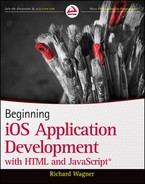Contents
Chapter 1: Introducing IOS Development Using Web Technologies
Discovering the Safari on IOS Platform
Key Safari Features for Web Developers
Four Ways to Develop Web Apps for IOS
Setting Up Your Development Environment on a Local Network
Chapter 2: Working With Core Technologies
Exploring HTML 5 Media Elements
Chapter 3: The Document Object Model
Accessing the DOM from JavaScript
Chapter 4: Writing Your First Hello World Application
Chapter 5: Enabling And Optimizing Web Sites For The IPHONE and IPAD
Tier 2: Navigation-Friendly Websites
Chapter 6: Designing The IPHONE UI
Best Practices in IOS UI Design
CSS Selectors Supported in Safari
Creating CSS-based IOS Buttons
Part III: Application Development
Chapter 9: Programming The Interface
Displaying a Panel with an Internal URL
Creating a Secondary Navigation List
Designing for Long Navigation Lists
Chapter 10: Handling Touch Interactions and Events
Detecting an Orientation Change
Changing Element Positioning Based on Orientation Change
Trapping for Key Events with the On-Screen Keyboard
Chapter 11: Special Effects and Animation
Chapter 12: Integrating With IOS Services
Making Phone Calls from Your App
Chapter 13: Packaging APPS as Bookmarks: Bookmarklets and Data Urls
Storing an Application in a Data URL
Part IV: Advanced Programming Techniques
Chapter 14: Programming The Canvas
Chapter 15: Offline Applications
HTML 5 Offline Application Cache
Going SQL with the JavaScript Database
Chapter 16: Building With Web APP Frameworks
Chapter 17: Bandwidth and Performance Optimizations
Best Practices to Minimize Bandwidth
JavaScript Performance Optimizations
Dot Notation and Property Lookups
Simulating the iPhone or iPad on Your Development Computer
Working with Desktop Safari Debugging Tools
Part V: Next Steps: Developing Native IOS Applications With Html and Javascript
Chapter 19: Preparing For Native IOS Development
Joining the IOS Developer Program
Getting an IOS Developer Certificate
Retrieving the Developer Certificate
Creating a Provisioning Profile
Installing the Development Provisioning Profile
Chapter 20: Phonegap: Native APPS From Your HTML, CSS, and Javascript
Creating a New PhoneGap Project in Xcode
Adding Web Files to the Xcode Project
Chapter 21: Submitting Your APP to The APP Store
Step 1: Getting a Distribution Certificate
Step 2: Creating a Distribution Provisioning Profile
Step 3: Building a Distribution Release of Your App
